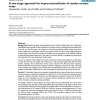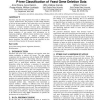59 search results - page 7 / 12 » The Integration of Multiple Feature Representations for Prot... |
BMCBI
2004
13 years 7 months ago
2004
Background: Hidden Markov Models (HMMs) have proven very useful in computational biology for such applications as sequence pattern matching, gene-finding, and structure prediction...
BMCBI
2006
13 years 7 months ago
2006
Background: Protein topology representations such as residue contact maps are an important intermediate step towards ab initio prediction of protein structure. Although improvemen...
BICOB
2010
Springer
13 years 5 months ago
2010
Springer
Fold recognition is a key problem in computational biology that involves classifying protein sharing structural similarities into classes commonly known as "folds". Rece...
BMCBI
2010
13 years 7 months ago
2010
Background: Systems biologists are faced with the difficultly of analyzing results from large-scale studies that profile the activity of many genes, RNAs and proteins, applied in ...
SIGKDD
2002
13 years 7 months ago
2002
Genomics data has many properties that make it different from "typical" relational data. The presence of multi-valued attributes as well as the large number of null valu...


